Yucheng Zhu
VQualA 2025 Challenge on Visual Quality Comparison for Large Multimodal Models: Methods and Results
Sep 11, 2025

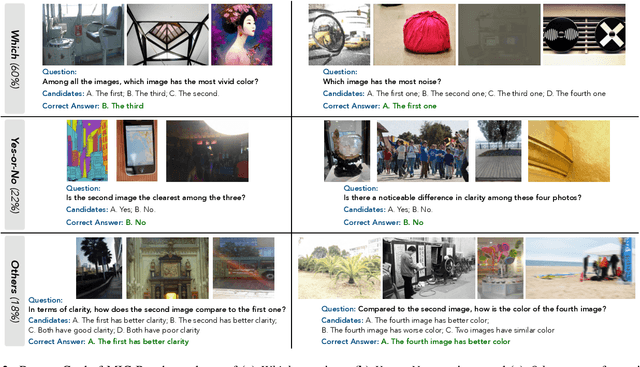
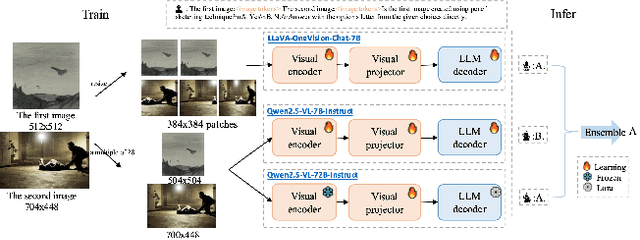
Abstract:This paper presents a summary of the VQualA 2025 Challenge on Visual Quality Comparison for Large Multimodal Models (LMMs), hosted as part of the ICCV 2025 Workshop on Visual Quality Assessment. The challenge aims to evaluate and enhance the ability of state-of-the-art LMMs to perform open-ended and detailed reasoning about visual quality differences across multiple images. To this end, the competition introduces a novel benchmark comprising thousands of coarse-to-fine grained visual quality comparison tasks, spanning single images, pairs, and multi-image groups. Each task requires models to provide accurate quality judgments. The competition emphasizes holistic evaluation protocols, including 2AFC-based binary preference and multi-choice questions (MCQs). Around 100 participants submitted entries, with five models demonstrating the emerging capabilities of instruction-tuned LMMs on quality assessment. This challenge marks a significant step toward open-domain visual quality reasoning and comparison and serves as a catalyst for future research on interpretable and human-aligned quality evaluation systems.
Can Large Models Fool the Eye? A New Turing Test for Biological Animation
Aug 08, 2025Abstract:Evaluating the abilities of large models and manifesting their gaps are challenging. Current benchmarks adopt either ground-truth-based score-form evaluation on static datasets or indistinct textual chatbot-style human preferences collection, which may not provide users with immediate, intuitive, and perceptible feedback on performance differences. In this paper, we introduce BioMotion Arena, a novel framework for evaluating large language models (LLMs) and multimodal large language models (MLLMs) via visual animation. Our methodology draws inspiration from the inherent visual perception of motion patterns characteristic of living organisms that utilizes point-light source imaging to amplify the performance discrepancies between models. Specifically, we employ a pairwise comparison evaluation and collect more than 45k votes for 53 mainstream LLMs and MLLMs on 90 biological motion variants. Data analyses show that the crowd-sourced human votes are in good agreement with those of expert raters, demonstrating the superiority of our BioMotion Arena in offering discriminative feedback. We also find that over 90\% of evaluated models, including the cutting-edge open-source InternVL3 and proprietary Claude-4 series, fail to produce fundamental humanoid point-light groups, much less smooth and biologically plausible motions. This enables BioMotion Arena to serve as a challenging benchmark for performance visualization and a flexible evaluation framework without restrictions on ground-truth.
AGHI-QA: A Subjective-Aligned Dataset and Metric for AI-Generated Human Images
Apr 30, 2025



Abstract:The rapid development of text-to-image (T2I) generation approaches has attracted extensive interest in evaluating the quality of generated images, leading to the development of various quality assessment methods for general-purpose T2I outputs. However, existing image quality assessment (IQA) methods are limited to providing global quality scores, failing to deliver fine-grained perceptual evaluations for structurally complex subjects like humans, which is a critical challenge considering the frequent anatomical and textural distortions in AI-generated human images (AGHIs). To address this gap, we introduce AGHI-QA, the first large-scale benchmark specifically designed for quality assessment of AGHIs. The dataset comprises 4,000 images generated from 400 carefully crafted text prompts using 10 state of-the-art T2I models. We conduct a systematic subjective study to collect multidimensional annotations, including perceptual quality scores, text-image correspondence scores, visible and distorted body part labels. Based on AGHI-QA, we evaluate the strengths and weaknesses of current T2I methods in generating human images from multiple dimensions. Furthermore, we propose AGHI-Assessor, a novel quality metric that integrates the large multimodal model (LMM) with domain-specific human features for precise quality prediction and identification of visible and distorted body parts in AGHIs. Extensive experimental results demonstrate that AGHI-Assessor showcases state-of-the-art performance, significantly outperforming existing IQA methods in multidimensional quality assessment and surpassing leading LMMs in detecting structural distortions in AGHIs.
Omni$^2$: Unifying Omnidirectional Image Generation and Editing in an Omni Model
Apr 15, 2025Abstract:$360^{\circ}$ omnidirectional images (ODIs) have gained considerable attention recently, and are widely used in various virtual reality (VR) and augmented reality (AR) applications. However, capturing such images is expensive and requires specialized equipment, making ODI synthesis increasingly important. While common 2D image generation and editing methods are rapidly advancing, these models struggle to deliver satisfactory results when generating or editing ODIs due to the unique format and broad 360$^{\circ}$ Field-of-View (FoV) of ODIs. To bridge this gap, we construct \textbf{\textit{Any2Omni}}, the first comprehensive ODI generation-editing dataset comprises 60,000+ training data covering diverse input conditions and up to 9 ODI generation and editing tasks. Built upon Any2Omni, we propose an \textbf{\underline{Omni}} model for \textbf{\underline{Omni}}-directional image generation and editing (\textbf{\textit{Omni$^2$}}), with the capability of handling various ODI generation and editing tasks under diverse input conditions using one model. Extensive experiments demonstrate the superiority and effectiveness of the proposed Omni$^2$ model for both the ODI generation and editing tasks.
ESVQA: Perceptual Quality Assessment of Egocentric Spatial Videos
Dec 29, 2024



Abstract:With the rapid development of eXtended Reality (XR), egocentric spatial shooting and display technologies have further enhanced immersion and engagement for users. Assessing the quality of experience (QoE) of egocentric spatial videos is crucial to ensure a high-quality viewing experience. However, the corresponding research is still lacking. In this paper, we use the embodied experience to highlight this more immersive experience and study the new problem, i.e., embodied perceptual quality assessment for egocentric spatial videos. Specifically, we introduce the first Egocentric Spatial Video Quality Assessment Database (ESVQAD), which comprises 600 egocentric spatial videos and their mean opinion scores (MOSs). Furthermore, we propose a novel multi-dimensional binocular feature fusion model, termed ESVQAnet, which integrates binocular spatial, motion, and semantic features to predict the perceptual quality. Experimental results demonstrate the ESVQAnet outperforms 16 state-of-the-art VQA models on the embodied perceptual quality assessment task, and exhibits strong generalization capability on traditional VQA tasks. The database and codes will be released upon the publication.
How Does Audio Influence Visual Attention in Omnidirectional Videos? Database and Model
Aug 10, 2024



Abstract:Understanding and predicting viewer attention in omnidirectional videos (ODVs) is crucial for enhancing user engagement in virtual and augmented reality applications. Although both audio and visual modalities are essential for saliency prediction in ODVs, the joint exploitation of these two modalities has been limited, primarily due to the absence of large-scale audio-visual saliency databases and comprehensive analyses. This paper comprehensively investigates audio-visual attention in ODVs from both subjective and objective perspectives. Specifically, we first introduce a new audio-visual saliency database for omnidirectional videos, termed AVS-ODV database, containing 162 ODVs and corresponding eye movement data collected from 60 subjects under three audio modes including mute, mono, and ambisonics. Based on the constructed AVS-ODV database, we perform an in-depth analysis of how audio influences visual attention in ODVs. To advance the research on audio-visual saliency prediction for ODVs, we further establish a new benchmark based on the AVS-ODV database by testing numerous state-of-the-art saliency models, including visual-only models and audio-visual models. In addition, given the limitations of current models, we propose an innovative omnidirectional audio-visual saliency prediction network (OmniAVS), which is built based on the U-Net architecture, and hierarchically fuses audio and visual features from the multimodal aligned embedding space. Extensive experimental results demonstrate that the proposed OmniAVS model outperforms other state-of-the-art models on both ODV AVS prediction and traditional AVS predcition tasks. The AVS-ODV database and OmniAVS model will be released to facilitate future research.
SG-JND: Semantic-Guided Just Noticeable Distortion Predictor For Image Compression
Aug 08, 2024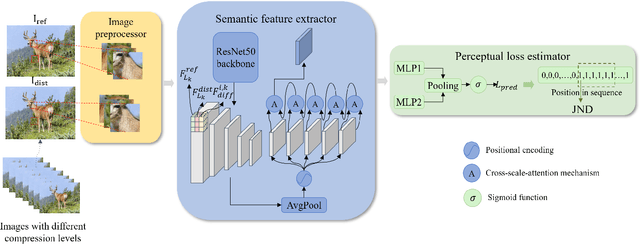

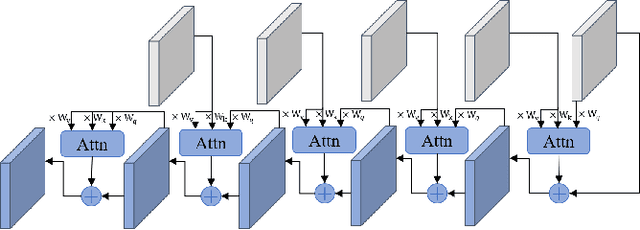

Abstract:Just noticeable distortion (JND), representing the threshold of distortion in an image that is minimally perceptible to the human visual system (HVS), is crucial for image compression algorithms to achieve a trade-off between transmission bit rate and image quality. However, traditional JND prediction methods only rely on pixel-level or sub-band level features, lacking the ability to capture the impact of image content on JND. To bridge this gap, we propose a Semantic-Guided JND (SG-JND) network to leverage semantic information for JND prediction. In particular, SG-JND consists of three essential modules: the image preprocessing module extracts semantic-level patches from images, the feature extraction module extracts multi-layer features by utilizing the cross-scale attention layers, and the JND prediction module regresses the extracted features into the final JND value. Experimental results show that SG-JND achieves the state-of-the-art performance on two publicly available JND datasets, which demonstrates the effectiveness of SG-JND and highlight the significance of incorporating semantic information in JND assessment.
MVBIND: Self-Supervised Music Recommendation For Videos Via Embedding Space Binding
May 15, 2024



Abstract:Recent years have witnessed the rapid development of short videos, which usually contain both visual and audio modalities. Background music is important to the short videos, which can significantly influence the emotions of the viewers. However, at present, the background music of short videos is generally chosen by the video producer, and there is a lack of automatic music recommendation methods for short videos. This paper introduces MVBind, an innovative Music-Video embedding space Binding model for cross-modal retrieval. MVBind operates as a self-supervised approach, acquiring inherent knowledge of intermodal relationships directly from data, without the need of manual annotations. Additionally, to compensate the lack of a corresponding musical-visual pair dataset for short videos, we construct a dataset, SVM-10K(Short Video with Music-10K), which mainly consists of meticulously selected short videos. On this dataset, MVBind manifests significantly improved performance compared to other baseline methods. The constructed dataset and code will be released to facilitate future research.
AIGCOIQA2024: Perceptual Quality Assessment of AI Generated Omnidirectional Images
Apr 01, 2024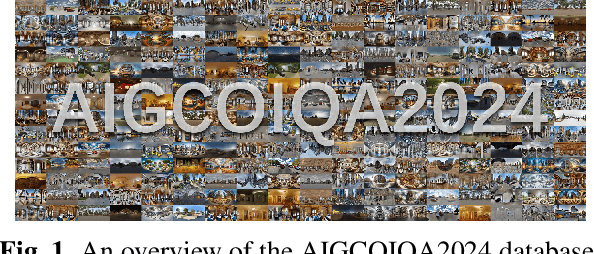
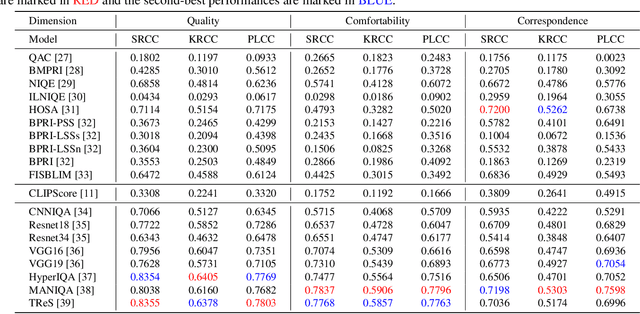
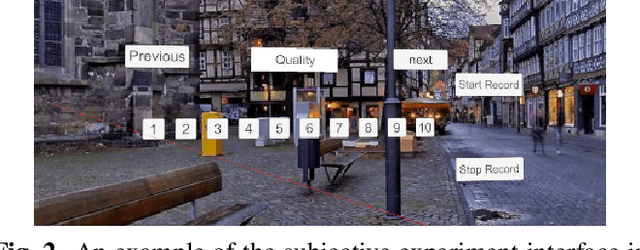

Abstract:In recent years, the rapid advancement of Artificial Intelligence Generated Content (AIGC) has attracted widespread attention. Among the AIGC, AI generated omnidirectional images hold significant potential for Virtual Reality (VR) and Augmented Reality (AR) applications, hence omnidirectional AIGC techniques have also been widely studied. AI-generated omnidirectional images exhibit unique distortions compared to natural omnidirectional images, however, there is no dedicated Image Quality Assessment (IQA) criteria for assessing them. This study addresses this gap by establishing a large-scale AI generated omnidirectional image IQA database named AIGCOIQA2024 and constructing a comprehensive benchmark. We first generate 300 omnidirectional images based on 5 AIGC models utilizing 25 text prompts. A subjective IQA experiment is conducted subsequently to assess human visual preferences from three perspectives including quality, comfortability, and correspondence. Finally, we conduct a benchmark experiment to evaluate the performance of state-of-the-art IQA models on our database. The database will be released to facilitate future research.
Perceptual Video Quality Assessment: A Survey
Feb 05, 2024Abstract:Perceptual video quality assessment plays a vital role in the field of video processing due to the existence of quality degradations introduced in various stages of video signal acquisition, compression, transmission and display. With the advancement of internet communication and cloud service technology, video content and traffic are growing exponentially, which further emphasizes the requirement for accurate and rapid assessment of video quality. Therefore, numerous subjective and objective video quality assessment studies have been conducted over the past two decades for both generic videos and specific videos such as streaming, user-generated content (UGC), 3D, virtual and augmented reality (VR and AR), high frame rate (HFR), audio-visual, etc. This survey provides an up-to-date and comprehensive review of these video quality assessment studies. Specifically, we first review the subjective video quality assessment methodologies and databases, which are necessary for validating the performance of video quality metrics. Second, the objective video quality assessment algorithms for general purposes are surveyed and concluded according to the methodologies utilized in the quality measures. Third, we overview the objective video quality assessment measures for specific applications and emerging topics. Finally, the performances of the state-of-the-art video quality assessment measures are compared and analyzed. This survey provides a systematic overview of both classical works and recent progresses in the realm of video quality assessment, which can help other researchers quickly access the field and conduct relevant research.
 Add to Chrome
Add to Chrome Add to Firefox
Add to Firefox Add to Edge
Add to Edge